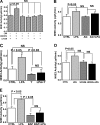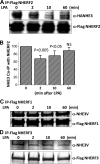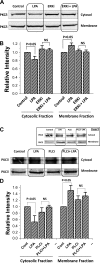Lysophosphatidic acid stimulation of NHE3 exocytosis in polarized epithelial cells occurs with release from NHERF2 via ERK-PLC-PKCδ signaling
- PMID: 24760985
- PMCID: PMC4080180
- DOI: 10.1152/ajpcell.00045.2014
Lysophosphatidic acid stimulation of NHE3 exocytosis in polarized epithelial cells occurs with release from NHERF2 via ERK-PLC-PKCδ signaling
Abstract
The Na(+)/H(+) exchanger 3 (NHE3) is a brush border (BB) Na(+)/H(+) antiporter that accounts for the majority of physiologic small intestinal and renal Na(+) absorption. It is regulated physiologically and in disease via changes in endocytosis/exocytosis. Paradoxically, NHE3 is fixed to the microvillar (MV) actin cytoskeleton and has little basal mobility. This fixation requires NHE3 binding to the multi-PDZ domain scaffold proteins Na(+)/H(+) exchanger regulatory factor (NHERF)1 and NHERF2 and to ezrin. Coordinated release of NHE3 from the MV cytoskeleton has been demonstrated during both stimulation and inhibition of NHE3. However, the signaling molecules involved in coordinating NHE3 trafficking and cytoskeletal association have not been identified. This question was addressed by studying lysophosphatidic acid (LPA) stimulation of NHE3 in polarized renal proximal tubule opossum kidney (OK) cells that occurs via apical LPA5 receptors and is NHERF2 dependent and mediated by epidermal growth factor receptor (EGFR), Rho/Rho-associated kinase (ROCK), and ERK. NHE3 activity was determined by BCECF/fluorometry and NHE3 microvillar mobility by FRAP/confocal microscopy using NHE3-EGFP. Apical LPA (3 μM)/LPA5R stimulated NHE3 activity, increased NHE3 mobility, and decreased the NHE3/NHERF2 association. The LPA stimulation of NHE3 was also PKCδ dependent. PKCδ was necessary for LPA stimulation of NHE3 mobility and NHE3/NHERF2 association. Moreover, the LPA-induced translocation to the membrane of PKCδ was both ERK and phospholipase C dependent with ERK acting upstream of PLC. We conclude that LPA stimulation of NHE3 exocytosis includes a signaling pathway that regulates fixation of NHE3 to the MV cytoskeleton. This involves a signaling module consisting of ERK-PLC-PKCδ, which dynamically and reversibly releases NHE3 from NHERF2 to contribute to the changes in NHE3 MV mobility.
Keywords: FRAP; NHE3; PDZ domain; microvillus; trafficking.
Copyright © 2014 the American Physiological Society.
Figures












Similar articles
-
NHE3 mobility in brush borders increases upon NHERF2-dependent stimulation by lyophosphatidic acid.J Cell Sci. 2010 Jul 15;123(Pt 14):2434-43. doi: 10.1242/jcs.056713. Epub 2010 Jun 22. J Cell Sci. 2010. PMID: 20571054 Free PMC article.
-
Both NHERF3 and NHERF2 are necessary for multiple aspects of acute regulation of NHE3 by elevated Ca2+, cGMP, and lysophosphatidic acid.Am J Physiol Gastrointest Liver Physiol. 2018 Jan 1;314(1):G81-G90. doi: 10.1152/ajpgi.00140.2017. Epub 2017 Sep 7. Am J Physiol Gastrointest Liver Physiol. 2018. PMID: 28882822 Free PMC article.
-
NHERF2 protein mobility rate is determined by a unique C-terminal domain that is also necessary for its regulation of NHE3 protein in OK cells.J Biol Chem. 2013 Jun 7;288(23):16960-16974. doi: 10.1074/jbc.M113.470799. Epub 2013 Apr 23. J Biol Chem. 2013. PMID: 23612977 Free PMC article.
-
The epithelial brush border Na+/H+ exchanger NHE3 associates with the actin cytoskeleton by binding to ezrin directly and via PDZ domain-containing Na+/H+ exchanger regulatory factor (NHERF) proteins.Clin Exp Pharmacol Physiol. 2008 Aug;35(8):863-71. doi: 10.1111/j.1440-1681.2008.04931.x. Epub 2008 Apr 21. Clin Exp Pharmacol Physiol. 2008. PMID: 18430067 Review.
-
NHE3 regulatory complexes.J Exp Biol. 2009 Jun;212(Pt 11):1638-46. doi: 10.1242/jeb.028605. J Exp Biol. 2009. PMID: 19448074 Free PMC article. Review.
Cited by
-
Nonsynonymous single nucleotide polymorphisms of NHE3 differentially decrease NHE3 transporter activity.Am J Physiol Cell Physiol. 2015 May 1;308(9):C758-66. doi: 10.1152/ajpcell.00421.2014. Epub 2015 Feb 25. Am J Physiol Cell Physiol. 2015. PMID: 25715704 Free PMC article.
-
Reversible deficits in apical transporter trafficking associated with deficiency in diacylglycerol acyltransferase.Traffic. 2018 Nov;19(11):879-892. doi: 10.1111/tra.12608. Epub 2018 Sep 21. Traffic. 2018. PMID: 30095213 Free PMC article.
-
Phosphorylation of NHE3-S719 regulates NHE3 activity through the formation of multiple signaling complexes.Mol Biol Cell. 2017 Jul 1;28(13):1754-1767. doi: 10.1091/mbc.E16-12-0862. Epub 2017 May 11. Mol Biol Cell. 2017. PMID: 28495796 Free PMC article.
-
Matrix metalloproteinase-2-induced epidermal growth factor receptor transactivation impairs redox balance in vascular smooth muscle cells and facilitates vascular contraction.Redox Biol. 2018 Sep;18:181-190. doi: 10.1016/j.redox.2018.07.005. Epub 2018 Jul 9. Redox Biol. 2018. PMID: 30029165 Free PMC article.
-
Identification of Intestinal NaCl Absorptive-Anion Secretory Cells: Potential Functional Significance.Front Physiol. 2022 Jul 19;13:892112. doi: 10.3389/fphys.2022.892112. eCollection 2022. Front Physiol. 2022. PMID: 35928564 Free PMC article. Review.
References
-
- Cha B, Kenworthy A, Murtazina R, Donowitz M. The lateral mobility of NHE3 on the apical membrane of renal epithelial OK cells is limited by the PDZ domain proteins NHERF1/2, but is dependent on an intact actin cytoskeleton as determined by FRAP. J Cell Sci 117: 3353–3365, 2004 - PubMed
-
- Cha B, Kim JH, Hut H, Hogema BM, Nadarja J, Zizak M, Cavet M, Lee-Kwon W, Lohmann SM, Smolenski A, Tse CM, Yun C, de Jonge HR, Donowitz M. cGMP inhibition of Na+/H+ antiporter 3 (NHE3) requires PDZ domain adapter NHERF2, a broad specificity protein kinase G-anchoring protein. J Biol Chem 280: 16642–16650, 2005 - PubMed
-
- Choi JW, Lim S, Oh YS, Kim EK, Kim SH, Kim YH, Heo K, Kim J, Kim JK, Yang YR, Ryu SH, Suh PG. Subtype-specific role of phospholipase C-beta in bradykinin and LPA signaling through differential binding of different PDZ scaffold proteins. Cell Signal 22: 1153–1161, 2010 - PubMed
Publication types
MeSH terms
Substances
Grants and funding
LinkOut - more resources
Full Text Sources
Other Literature Sources
Research Materials
Miscellaneous

